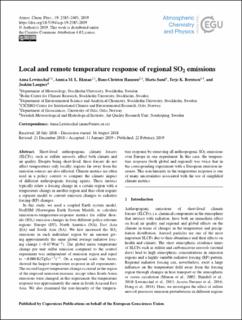| dc.contributor.author | Lewinschal, Anna | |
| dc.contributor.author | Ekman, Annica M. L. | |
| dc.contributor.author | Hansson, Hans-Christen | |
| dc.contributor.author | Sand, Maria | |
| dc.contributor.author | Berntsen, Terje Koren | |
| dc.contributor.author | Langner, Joakim | |
| dc.date.accessioned | 2021-06-17T12:49:43Z | |
| dc.date.available | 2021-06-17T12:49:43Z | |
| dc.date.created | 2019-06-03T14:32:47Z | |
| dc.date.issued | 2019 | |
| dc.identifier.citation | Atmospheric Chemistry and Physics. 2019, 19 (4), 2385-2403. | en_US |
| dc.identifier.issn | 1680-7316 | |
| dc.identifier.uri | https://hdl.handle.net/11250/2759996 | |
| dc.description.abstract | Short-lived anthropogenic climate forcers (SLCFs), such as sulfate aerosols, affect both climate and
air quality. Despite being short-lived, these forcers do not affect temperatures only locally; regions far away from the emission sources are also affected. Climate metrics are often used in a policy context to compare the climate impact of different anthropogenic forcing agents. These metrics typically relate a forcing change in a certain region with a temperature change in another region and thus often require a separate model to convert emission changes to radiative forcing (RF) changes. In this study, we used a coupled Earth system model, NorESM (Norwegian Earth System Model), to calculate
emission-to-temperature-response metrics for sulfur diox ide (SO2) emission changes in four different policy-relevant regions: Europe (EU), North America (NA), East Asia (EA) and South Asia (SA). We first increased the SO2 emissions in each individual region by an amount giv ing approximately the same global average radiative forc ing change (−0.45 Wm−2 ). The global mean temperature
change per unit sulfur emission compared to the control experiment was independent of emission region and equal to ∼0.006 K(TgSyr−1) −1 . On a regional scale, the Arctic showed the largest temperature response in all experiments. The second largest temperature change occurred in the region of the imposed emission increase, except when South Asian emissions were changed; in this experiment, the temperature response was approximately the same in South Asia and East Asia. We also examined the non-linearity of the temperature response by removing all anthropogenic SO2 emissions over Europe in one experiment. In this case, the tempera ture response (both global and regional) was twice that in
the corresponding experiment with a European emission increase. This non-linearity in the temperature response is one of many uncertainties associated with the use of simplified climate metrics. | en_US |
| dc.language.iso | eng | en_US |
| dc.publisher | Copernicus publications | en_US |
| dc.rights | Navngivelse 4.0 Internasjonal | * |
| dc.rights.uri | http://creativecommons.org/licenses/by/4.0/deed.no | * |
| dc.title | Local and remote temperature response of regional SO2 emissions | en_US |
| dc.type | Journal article | en_US |
| dc.type | Peer reviewed | en_US |
| dc.description.version | publishedVersion | en_US |
| dc.source.pagenumber | 2385-2403 | en_US |
| dc.source.volume | 19 | en_US |
| dc.source.journal | Atmospheric Chemistry and Physics | en_US |
| dc.source.issue | 4 | en_US |
| dc.identifier.doi | 10.5194/acp-19-2385-2019 | |
| dc.identifier.cristin | 1702348 | |
| cristin.unitcode | 7475,0,0,0 | |
| cristin.unitname | CICERO Senter for klimaforskning | |
| cristin.ispublished | true | |
| cristin.fulltext | original | |
| cristin.qualitycode | 2 | |

